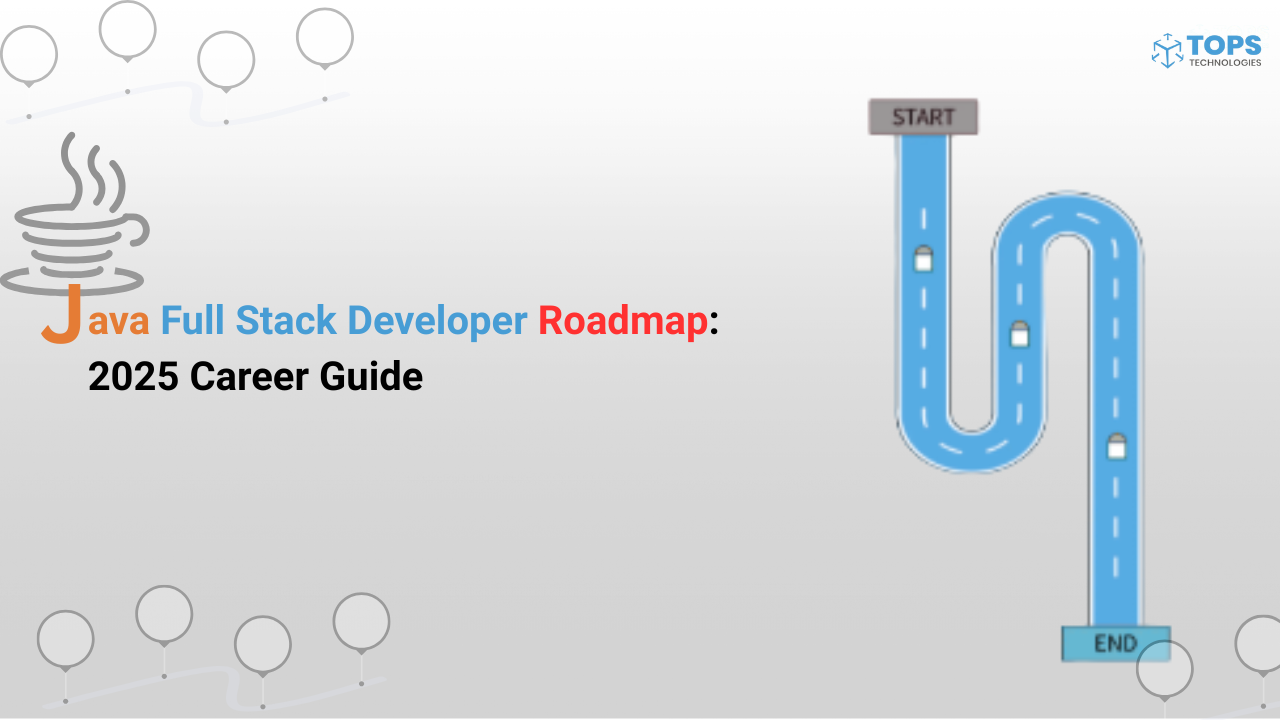
In the rapidly evolving world of technology, the demand for skilled full stack developers continues to surge. A full stack developer is someone who can handle both the front-end and back-end aspects of web development, making them a valuable asset to any company. In 2025, one of the most in-demand and reliable technology stacks is the Java Full Stack. Java, known for its stability, scalability, and enterprise-level capabilities, has been a favorite of large organizations for decades. Pair it with modern front-end frameworks, and you have a powerful combination ready to tackle the needs of today’s digital world.
This guide is crafted to help aspiring developers navigate their way through the Java full stack journey in 2025. Whether you're a college student, a recent graduate, or a professional switching careers, this article will serve as a complete roadmap to help you become industry-ready.
Understanding the Role of a Full Stack Developer
A full stack developer is proficient in both front-end and back-end development, which means they can build an entire web application from start to finish. On the front-end, they work with technologies that users interact with directly, such as the layout, buttons, and overall user interface. On the back-end, they deal with servers, databases, and the business logic that powers the application.
Being a full stack developer not only increases your value in the job market but also allows you to understand the complete software development lifecycle. You can communicate effectively with both designers and backend teams, contributing to more cohesive and efficient project development.
Why Choose Java for Full Stack Development?
Java has stood the test of time. Known for its portability, robustness, and performance, it powers some of the world’s most complex enterprise systems. Its long-standing presence in the market means a vast ecosystem of tools, frameworks, libraries, and community support. In the full stack domain, Java fits perfectly on the server side thanks to powerful frameworks like Spring Boot, which allows developers to build scalable and secure back-end applications.
Additionally, Java integrates seamlessly with modern front-end frameworks like React or Angular through RESTful APIs. This compatibility makes it ideal for full stack development where communication between the client and server needs to be efficient and secure.
The Front-End Foundation
A full stack developer must have a solid understanding of front-end development. This is where user experience comes into play. Technologies such as HTML, CSS, and JavaScript are the backbone of any web page. HTML structures the content, CSS styles it, and JavaScript makes it interactive. In 2025, it’s essential to master modern JavaScript (ES6+) as it introduces features like arrow functions, classes, promises, and modules, which enhance code readability and functionality.
Beyond these core languages, choosing a front-end framework is crucial. React, developed by Facebook, is a popular choice due to its component-based architecture and virtual DOM, which significantly improves performance. Angular, backed by Google, offers a structured approach using TypeScript and is preferred for large-scale applications. Vue.js, while lighter, is gaining traction for its simplicity and flexibility.
By mastering front-end development, you ensure that users have a seamless and engaging experience when interacting with your applications.
Mastering Back-End with Java
The server-side logic of an application is just as important as its interface. Java shines in this area, offering a robust and secure environment for building powerful back-end systems. To become proficient, one must first understand core Java concepts such as object-oriented programming, data structures, exception handling, file I/O, and multi-threading. These fundamentals lay the groundwork for more advanced back-end development.
Spring Boot, an extension of the Spring framework, simplifies the development of production-ready applications. With features like dependency injection, embedded servers, and auto-configuration, Spring Boot allows developers to build REST APIs efficiently. These APIs serve as the communication bridge between the front-end and back-end, transferring data in formats like JSON.
Hibernate is another essential tool, providing an abstraction layer over traditional database operations. It enables seamless interaction with relational databases by mapping Java objects to database tables, making CRUD operations more intuitive and reducing boilerplate code.
Database Management Skills
No application is complete without a reliable database. Full stack developers must be well-versed in both SQL and NoSQL databases. SQL databases such as MySQL and PostgreSQL are perfect for structured data and transactions, offering strong ACID compliance. They are ideal for applications like e-commerce platforms, banking software, and inventory systems.
However, not all data fits neatly into tables. This is where NoSQL databases like MongoDB come into play. MongoDB stores data in flexible, JSON-like documents, making it suitable for applications with dynamic or hierarchical data. Learning to work with both types of databases equips you with the flexibility to choose the right tool for any project.
Understanding how to model data, write efficient queries, and optimize performance are critical skills for any backend developer.
The Importance of DevOps Tools
Modern development is incomplete without DevOps. Knowing how to use DevOps tools helps you streamline development, testing, and deployment processes. Version control systems like Git allow you to track changes in your code, collaborate with others, and revert to previous versions when necessary. Platforms like GitHub serve as repositories for your projects and portfolios, showcasing your work to potential employers.
Build tools such as Maven and Gradle automate the compilation and packaging of Java projects, making deployment more efficient. They manage dependencies, compile source code, and generate build artifacts with minimal manual intervention.
For deployment and scaling, Docker and Kubernetes are game changers. Docker allows you to containerize your applications, ensuring that they run consistently across different environments. Kubernetes helps you manage and scale these containers, making your applications highly available and fault-tolerant.
Understanding SDLC and Agile Practices
Being technically strong is not enough—you also need to understand how software is developed in a real-world business environment. The Software Development Lifecycle (SDLC) outlines the stages from planning and designing to developing, testing, deploying, and maintaining software.
Agile methodologies have become the norm, encouraging iterative development and regular feedback. As a full stack developer, you will often participate in daily stand-ups, sprint planning meetings, and retrospectives. Familiarity with CI/CD (Continuous Integration/Continuous Deployment) practices is crucial, allowing you to automatically test and deploy your code using tools like Jenkins.
Additionally, writing tests is an essential part of delivering quality code. Libraries like JUnit and Mockito help you write unit and integration tests, ensuring that each component of your application works as expected.
Step-by-Step Roadmap to Mastery
Your journey to becoming a full stack Java developer can be broken down into clear, actionable steps. Start by learning core Java—without this, you’ll struggle with backend development. Once you’re comfortable, move to front-end basics. HTML, CSS, and JavaScript are relatively easy to grasp and provide instant visual feedback, which keeps motivation high.
Next, dive into Spring Boot. This is where the backend magic happens. Learn to build REST APIs and connect them to your front-end interface. From here, integrate databases to store and retrieve data dynamically.
Once you have the core stack, it’s time to adopt essential tools. Learn Git for version control, use Maven for building Java applications, and understand Docker and Jenkins for deployment. Practice continuous learning by working on projects that combine all your skills.
Building Real Projects
Projects are the best way to solidify your knowledge and demonstrate your skills. Start with a simple portfolio website, then move on to more complex applications. For example, build an e-commerce platform where users can register, browse products, add items to a cart, and make payments. Include an admin panel for managing inventory and tracking orders.
You could also create a task manager where users can create, update, and delete tasks. Include features like user authentication, due dates, and task priorities. These real-world projects mimic the kind of work you’ll do professionally and are perfect for your portfolio.
Certifications and Online Courses
While experience and skills are most important, certifications can give you an edge in a competitive market. Oracle offers industry-recognized Java certifications that validate your knowledge and expertise. Platforms like TOPS Technologies provide specialized full stack courses that include project work and placement support.
If you're a self-learner, platforms like Udemy, Coursera, and freeCodeCamp offer high-quality courses at an affordable cost or even free. Make sure the course covers the latest tools and includes hands-on assignments.
Career Scope and Job Market in 2025
In 2025, the demand for Java full stack developers is expected to grow even further. Businesses across industries—finance, healthcare, e-commerce, education—are digitizing their operations, creating a surge in full stack development jobs. Roles such as Java Developer, Backend Engineer, and Full Stack Engineer are frequently listed on job portals.
Salaries vary depending on your experience, location, and skills. In India, entry-level developers can expect ₹5–7 LPA, while those with 3–5 years of experience can command ₹12–18 LPA. In the U.S., the average salary ranges from $80,000 to $140,000. Remote opportunities are also booming, offering flexibility and global exposure.
Tips to Succeed in Interviews
To land your dream job, you must excel in interviews. Start by practicing coding problems on platforms like LeetCode, HackerRank, and CodeSignal. These help you think algorithmically and prepare you for technical rounds.
You should also be prepared for system design interviews. Be ready to discuss how you would design scalable systems like a URL shortener or a chat app. Understand architecture patterns like microservices, monoliths, and event-driven design.
Finally, work on your communication skills. Talk confidently about your projects, the challenges you faced, and how you solved them. A strong GitHub profile can serve as a portfolio that impresses recruiters.
Staying Updated and Learning Continuously
Technology changes fast. To stay relevant, follow blogs like Baeldung, subscribe to YouTube channels like Java Brains, and read documentation regularly. Engage in developer communities on GitHub, Stack Overflow, and Reddit.
Contribute to open-source projects if possible. It not only builds your skills but also connects you with experienced developers who can mentor and guide you.
Conclusion
Becoming a Java full stack developer in 2025 is more than just a career move—it's a commitment to continuous learning and growth. By mastering front-end and back-end technologies, understanding the tools and workflows used in real-world environments, and building a strong portfolio, you set yourself up for a future-proof career in tech. The journey may be long, but with dedication, it’s entirely achievable. So, gear up, follow this roadmap, and take the first step toward your dream job today!






